
by Nic Haygarth | 23/05/25 | Story of the thylacine
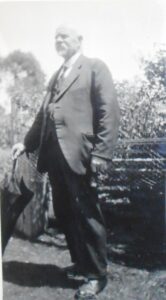
James ‘Tiger’ Harrison, Wynyard native animals dealer, snarer, prospector, track cutter, estate agent, shipping agent, Christian Brethren registrar, tourist chauffeur, human ‘cork’ and Crown bailiff of fossils. Photo from the Norman Larid files, NS1143, Tasmanian Archives (TA).
In the mid-1920s thylacines were still reported by bushmen in remote parts of the north-west. Luke Etchell claimed there was a time when he caught six or seven ‘native tigers’ per season at the Surrey Hills.[1] Like Brown brothers at Guildford, Van Diemen’s Land Company (VDL Co) hands at Woolnorth were still doing a trade in live native animals—although the latter property was out of tigers. On 7 July 1925 Hobart City Council paid the VDL Co £60 10 shillings for what can only be described as two loads of ‘animals’—presumably Tasmanian devils and quolls—recorded as being carted out to the nearest post office at Montagu during the previous month.[2] A further transaction of £30 was recorded in October 1925, when it is possible Woolnorth manager George Wainwright junior hand delivered a crate of live native animals to Hobart’s Beaumaris Zoo.[3]
James ‘Tiger’ Harrison (1860–1943) of Wynyard took his animals dead or alive. He bought and sold living Tasmanian birds and marsupials, including tigers, but also hunted for furs in winter. In July 1926 Harrison and his Wynyard friend George Easton (1864–1951) secured government funding of £2 per week each to prospect south of the Arthur River for eight weeks.[4] However, their main game was hunting: the two-month season opened on 1 July 1926.

James Harrison’s collaborators George Easton and George Smith with a bark boat used to rescue Easton at the Arthur River in 1929. Photo courtesy of Libby Mercer.

TOPOGRAPHIC BASEMAP FROM THELIST©STATE OF TASMANIA
Easton, an experienced bushman in his own right, made snares most evenings until the pair departed Wynyard on 14 July.[5] At Trowutta Station they boarded the horse-drawn, wooden-railed tram to the Arthur River that jointly served Lee’s and McKay’s Sawmills.[6] Next day, Arthur Armstrong from Trowutta arrived with a pack-horse bearing their stores, and the pair set out along the northern bank of the Arthur towards the old government-built hut on Aylett’s track.[7] However, on a walk to the Dempster Plains to shoot some wallaby to feed their dogs, Harrison injured his knee so badly that he couldn’t carry a pack. So before they had even set some snares the pair was forced to return home.[8] On their slow, rain-soaked journey they sold their stores to the Arthur River Sawmill boarding-house keeper Hayes—the only problem being delivery of said stores from their position up river.[9] While Harrison went home by horse tram and car, Easton had to help Armstrong the packer retrieve the stores.[10]
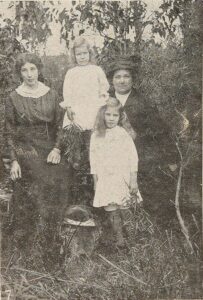
Martha Crole and her daughters. From the Weekly Courier, 10 April 1919, p.22.
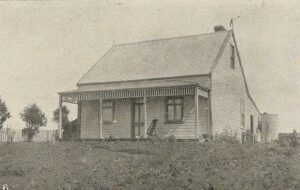
The Crole house at Trowutta. From the Weekly Courier, 10 April 1919, p.22.
‘Tiger country’ around the Arthur River
If not for the injury Harrison may have secured more than furs over the Arthur. One of the European pioneers in that area was grazier Fred Dempster (1863–1946), who appears to have rediscovered pastures celebrated by John Helder Wedge in 1828.[11] Out on his run in 1915 Dempster met a breakfast gatecrasher with cold steel. The elderly tiger reportedly measured 7 feet from nose to tail and being something of a gourmet registered 224 lbs on Dempster’s bathroom scales.[12] In dramatising this shooting, anonymous newspaper correspondent ‘Agricola’ mixed familiar thylacine attributes with the fanciful idea of its ferocity:
This part is the home of the true Tasmanian tiger … This animal must not be confounded with the smaller cat-headed species [he perhaps means the ‘tiger cat’, that is, spotted-tailed quoll, Dasyurus maculatus] so prevalent beyond Waratah, Henrietta and other places. The true species is absolutely fearless in man’s presence, and if he smells meat will follow the wayfarer on the lonely bush tracks for miles, stopping when he does and going on when he resumes his walk. It has been proved beyond question that these brutes will not shift off the paths when met by man, and they will always attack when cornered.[13]
One mainland newspaper was apparently so confused by ‘Agricola’s’ account that he called Dempster’s thylacine ‘a huge tiger cat’.[14]
Trowutta people had no problem distinguishing quoll from tiger. They caught the latter unwittingly while snaring. Fred and Martha Crole and family of Trowutta made hundreds of snares on a sewing machine, eating the wallaby meat and selling the skins they caught. One of their boys, Arthur Crole (1895–1972), landed a tiger alive in a snare, killed it, tanned the hide and used it as a bedside rug.[15] While south of the Arthur, Harrison and Easton were unlucky not to run into Trowutta farmers Fred and Violet Purdy, who caught a tiger in a footer snare there during the 1926 season. When the Purdys approached the captured animal it broke the snare and disappeared. However, tigers also frequently visited their hut south of the river at night and they saw their footprints in the mud next morning.[16] Violet Purdy claimed to have spent six months straight living in the ‘wild bush’ (the hunting season in 1926 was only July and August), and her observations of the thylacine suggest someone with at least second-hand knowledge. Like ‘Agricola’, she knew of the tiger’s reputed habit of refusing to move off a track to let a human pass. Unlike him, she attested to the animal’s shyness. Purdy recommended ‘a couple of good cattle dogs’ as the means of tracking it down. She and her husband found thylacine tracks at the Frankland River as they crossed it to reach the Dempster Plains.[17] Decades later Purdy regaled the Animals’ and Birds’ Protection Board with her tales, illustrating them with a map of ‘tiger country’ between Trowutta and the Dempster Plains.
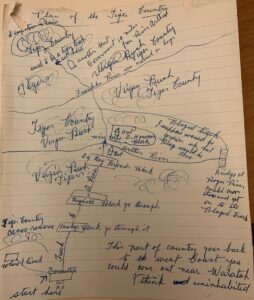
‘Tiger country’ between Trowutta and Dempster Plains, as it looked in 1926, according to Mrs V Kenevan,
formerly Violet Purdy of Trowutta. From AA612/1/59 (TA).
Snaring at Woolnorth
By the time Easton got home to Wynyard, Harrison, apparently recovered from his knee injury, had arranged for them both to snare at Woolnorth, where no swags needed to be carried, since stores were supplied. The VDL Co employed hunters every season to kill ‘game’, this serving the dual purpose of saving the grass for the stock and bringing the company income at a time of low agricultural prices. At this time hunters paid a royalty of one in six skins to the company.
Easton’s diary entries give rare insight into a hunting engagement. Harrison and Easton took the train to Smithton and caught the mail truck to Montagu, from which they were borne by chaise cart to the Woolnorth homestead. That night the snarers were put in a cottage generally reserved for the VDL Co agent, AK McGaw.[18] Next day station manager George Wainwright junior showed them their lodgings (tents next to a lagoon which served as the water supply) and how snaring (using springer snares but also neck snares along fences) and skinning were done at Woolnorth. Wainwright, an old hand, claimed to be able to skin 30 animals per hour.[19] Storms, horse leeches, which had a way of attaching themselves to the human scalp, and cutting springers and pegs kept the snarers very well occupied between snare inspections, an 11-km-long daily routine. The game was nearly all wallaby and ringtails, and Harrison and Easton dried their skins not in a skin shed but by hanging them in trees.[20] Bathing meant a sponge bath with a prospecting dish full of cold water—which also constituted the laundry facilities.[21] The last day of the season at Woolnorth was traditionally an all-in animal shoot, after which the season’s skins were baled, treated with an arsenic solution to kill insects and delivered to a skins dealer.[22] In the two-month 1926 season the VDL Co made £493 from the fur industry, a big reduction on the previous year (£1296) when the season had lasted three months.[23]
However, Harrison didn’t last the distance, calling it quits on 13 August after barely two weeks, leaving Easton to carry on alone until the season ended eighteen days later. Their skin tally at 13 August stood at 16½ dozen—198 skins or 99 apiece.[24]
Returning to ‘tiger country’
Once again ‘Tiger’ Harrison was in the wrong place at the wrong time to live up to his nickname. While he was working at tiger-free Woolnorth, timber worker, hunter and sometime miner Alf Forward snared two tigers, one alive, one choked to death by a stiff spring in a necker snare at the Salmon River Sawmill south of Smithton.[25] Forward is said to have exhibited the living one in Smithton before selling it to Harrison.[26] He almost had another live one in the following month, when a tiger detained by Forward’s snare for two days bit his capturer’s hand, thereby effecting its escape.[27]
Harrison eventually decided to cut out the middle-man. From 1927 he conducted expeditions specifically to obtain living thylacines to sell. He had no luck until in June 1929 he caught one 3 km south-west of Takone.[28] The Arthur River catchment remained ‘tiger country’ in the mid-1930s when ‘Pax’ (Michael Finnerty) and Roy Marthick claimed to have seen them while prospecting.[29] The question of whether they are there today still entertains Tarkine tourists and the worldwide thylacine mafia.
[1] MA Summers’ report, 14 May 1937, AA612/1/59 H/60/34 (Tasmanian Archives, henceforth TA).
[2 Payment recorded 7 July 1925. On 9 June 1925: ‘W Simpson taken animals to Montagu’; 22 June 1925: ‘W Simpson went to Montagu with load of animals’, Woolnorth farm diary, VDL277/1/53 (TA).
[3] Payment recorded on 13 October 1925. On 4 October 1925 George Wainwright junior and his wife departed Woolnorth for the Launceston Agricultural Show (Woolnorth farm diary VDL277/1/53). It is possible that he took a crate of animals on the train to Hobart.
[4] GW Easton diary, 1 July 1926 (held by Libby Mercer, Hobart).
[5] GW Easton diary, 1–14 July 1926.
[6] GW Easton diary, 15 July 1926.
[7] GW Easton diary, 16 July 1926.
[8] GW Easton diary, 18 July 1926.
[9] GW Easton diary, 23 July 1926.
[10] GW Easton diary, 25 and 26 July 1926.
[11] JH Wedge, ‘Official report of journeys made by JH Wedge, Esq, Assistant Surveyor, in the North-West Portion of Van Diemen’s Land, in the early part of the year 1828’, reprinted in Venturing westward: accounts of pioneering exploration in northern and western Tasmania by Messrs Gould, Gunn, Hellyer, Frodsham, Counsel and Sprent [and Wedge], Government Printer, Hobart, 1987, p.38.
[12] See for example ‘Boat Harbour’, North West Post, 22 February 1915, p.2. Dempster probably didn’t have any bathroom scales with him. Rather mysteriously, the author of ‘A huge tiger cat’, Westralian Worker, 19 March 1915, p.6, put the animal’s weight as ‘2 cwt’ (224 lbs).
[13] ‘Agricola’, ‘Farm jottings’, North West Post, 24 February 1915, p.4. In another column ‘Agricola’ claimed with equal dubiousness that under Mount Pearse trappers caught tigers in pits, and that if more than one tiger was collected in the same pit at the same time the captured animals would fight to the death. See ‘Agricola’, ‘Farm jottings’, North West Post, 10 July 1914, p.4.
[14] ‘A huge tiger cat’, Westralian Worker, 19 March 1915, p.6.
[15] Fred and Graham Crole, in Women’s stories: different stories—different lives—different experiences: a Circular Head oral history project (compiled and edited by Pat Brown and Helene Williamson), Forest, Tas, 2009, p.192.
[16] The hut was on Aylett’s Track to Balfour.
[17] Violet Kenevan, Kingswood, New South Wales, to secretary of the Animals’ and Birds’ Protection Board, 30 October 1956, AA612/1/59 (TA).
[18 GW Easton diary, 27 July 1926.
[19] GW Easton diary, 30 July 1926.
[20] GW Easton diary, 18 August 1926.
[21] GW Easton diary, 15 August 1926.
[22] GW Easton diary, 31 August and 6–9 September 1926; Woolnorth farm diary, 31 August 1926, VDL277/1/54 (TA).
[23] The figures are from VDL129/1/7 (TA).
[24] GW Easton diary, 13 August 1926.
[25] ‘Hyena choked in snare at Salmon River’, Circular Head Chronicle, 11 August 1926, p.5.
[26] ‘TT, from New Town’, ‘Tasmanian tiger’, Mercury, 24 August 1954, p.4, claimed that Alf Forward caught the animal in a kangaroo snare at the Salmon River ‘less than 30 years ago’ and sold it to Harrison after putting it on show in Smithton.
[27] ‘Hand bitten by a hyena’, Circular Head Chronicle, 29 September 1926, p.5.
[28 GW Easton diary, 17 June 1929; Circular Head Chronicle, 29 May 1929.
[29] See ‘Pax’ (Michael Finnerty), ‘A “bush-whacker’s” experience in the north-west’, Mercury, 6 May 1937, p.8; Roy Marthick to the Fauna Board, 10 February 1937 (TA); Roy Marthick quoted by Charles Barrett, ‘Out in the open: nature study for the schools’, Weekly Times (Melbourne), 10 July 1937, p.44.
by Nic Haygarth | 09/03/24 | Circular Head history
Lasseter’s Reef wasn’t the first pot of gold to go missing.[1] Many goldfields have their holy grails, the tale of a fabled reef found but then lost, tantalising generations of prospectors. On Tasmania’s Arthur River it was the reputed reef at the Blue Peaked Hill,[2] but even ‘Australia’s biggest dairy farm’ Woolnorth, in the state’s north-western corner, wears a tale of gilded woe.
The unlikely claimant at Woolnorth was John Elmer (1801–80), who is said to have been born at Barnham, St Edmundsbury Borough, in Suffolk, England. He married Frances Kemp in that town in 1823.[3] On 22 March 1832, along with their four daughters and five other men, they arrived at Stanley on the barque Forth as indentured servants to the Van Diemen’s Land Company (VDL Co).[4]

The Woolnorth property showing its original eastern boundary. TOPOGRAPHIC BASEMAP FROM THELIST copyright STATE OF TASMANIA
The settlement on the coast at Woolnorth Point was then only three years old, consisting of a store, six cottages, a stable, a blacksmith’s shop and a jetty where produce could be loaded and goods landed.[5] The place was isolated, conditions primitive and rations meagre. Indentured servants were required to stay long enough to work off their passage fares, but three Forth arrivals and two other indentured servants voted with their feet by absconding in October 1832.[6] The Elmers stayed, John’s employment even surviving an incident in October 1834 when he struck Woolnorth overseer Samuel Reeves during a pay dispute.[7] A splash of gold across the drudgery of tending Saxon ewes, draining marshland, milking cows and keeping house would have been welcome.[8] However, nobody entertained ideas of a gold bounty in the years before the Californian rushes of 1848–55. Few would have known gold if they fell over it.
Shepherd at Woolnorth and Cheshunt
The Elmer family endured a decade at remote Woolnorth before taking up a Launceston butchery.[9] That move landed John Elmer in the Insolvency Court, after which he appears to have joined the wool-grower, architect and botanist William Archer IV’s Cheshunt property south-west of Deloraine.[10] Elmer would have been an interesting witness on the subject of thylacine predation on sheep, having been a shepherd at a time when few attacks were reported at either Woolnorth or Cheshunt. In 1851, when Elmer was hired or rehired as a Cheshunt shepherd and overseer at an annual salary of £40, he and Frances already had a family of six young children.[11]
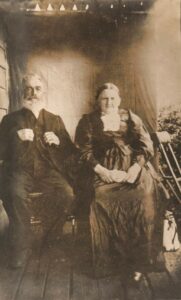
James (Edward James) Elmer and his wife Louisa Annie Diprose. Courtesy of Bruce Hull.
James Elmer
One of their offspring was Edward James Elmer (c1835–1916), who called himself James Elmer.[12] He claimed to be ‘the oldest white born under the VDL Company’. Many seventeen-year-olds must have raced off to the goldfields at Forest Creek, Loddon River or Creswick with their fathers circa 1852 when the mosquito fleet plying Bass Strait was laden with garrulous Van Diemen’s Land diggers. No shipping records place John or James Elmer among them.[13] A tour of the Victorian goldfields would have guaranteed the Elmers a familiarity with the appearance of alluvial gold and the conditions under which it was found. But it seems they stayed home keeping sheep and saving their pennies to take up a tenant farm at Cheshunt.[14]
A deathbed confession
John Elmer died as a supposedly senile 78-year-old at Bridgenorth, West Tamar in 1880.[15] On his deathbed he told James that at Woolnorth he’d done more than keep tigers from the sheep, having found ‘plenty of gold’.[16] The question of how exactly a Suffolk shepherd could have recognised gold a decade or two before the global gold bonanza began doesn’t seem to have fazed James. Nor did his father’s prescribed senility. Then there was the matter of why John Elmer—assuming he was literate—hadn’t exploited the reef himself by, for starters, sending rock samples to an assayer or a geologist. James’ problem was that he had developed a touch of gold fever, which is exactly what happened when you hung around with that ne’er-do-well Henry Weeks.
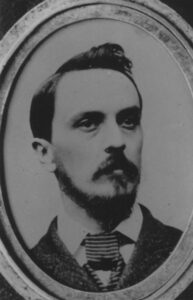
Chief Chummy’s gold chaser Henry Weeks. Courtesy of John Watts.
Henry Weeks and Chummy’s gold
Native Rock farmer Weeks (1832–99) was a staunch Rechabite.[17] His weakness didn’t come in a bottle but with a geological pick: he lost his nut to mineral prospecting and mining investment. Weeks had also missed the Victorian gold rushes, only arriving in Van Diemen’s Land from Monmouth, Wales, as an assisted immigrant coalminer in 1854.[18] He must have made up for lost time. Weeks’ discovery of the rich Mount Claude (Round Hill) galena mine in 1881 distracted him from the farm but did nothing for his bank balance.[19] Chasing Chummy’s gold didn’t help much either. This Lasseter’s Reef story involved George ‘Chummy’ Webb finding a fabulous gold reef in the Forth River high country—and taking the location to the grave with him, leaving his mate Henry Weeks to rediscover it. The only surviving clue to the site, ‘with the Western Tiers behind you and Cradle in front of you’, led all comers on a merry dance.[20]
The VDL Co goes mining
Weeks wasn’t alone in taking this tack. Frustrated by poor farming returns and tantalised by rich metal discoveries just outside its property, in 1882 the VDL Co began to examine its holdings for minerals.[21] Weeks or James Elmer evidently got wind of this, and with Henry Cooper put their names to a proposal to the company. The spelling is James Elmer’s:
‘I have been told that you want some party to prospect the companys land at Woolnorth if so we wold like to take the work, as have some knowledge of the place and my Father found gold thare fifty years ago and when he was dyen he told me as near as he cold were it was. My Father was shepherd there for manney years. I was down thare some few years ago and my mates got tired before we got thare and wold not stay when we got thare so wold not stop we are astickon [sic] party now thare are three of us but only two will be abell to go at a time. If you will let me know what terms we will try and agree as we wold mutch like to go down and find the big reef for thare is plenty of gold down there. We have all had a deal of practice in mining fore gold …’[22]
No VDL Co response has been found. After decades of dealing with mostly lackadaisical prospectors, VDL Co local agent James Norton Smith probably never took Elmer’s proposal seriously. The company’s prospector, a Cornishman named James Rowe, later found nothing of value at Woolnorth or any other VDL Co property, advising it to give up prospecting.[23]
Chummy keeps his secret
James Elmer didn’t give up. He still had the bug two decades later as a 70-year-old, repeating his father’s tale to Norton Smith’s successor Andrew Kidd McGaw:
‘I wold like to go and see if I cold find it. I wold have to drive down and cannot walk as I cold 50 years ago but am [not] a crippel yet. My horse wold do on the run aney ware so long as I got my tucker down. If I can go I will call and see you as am goen down I wold like to go soon …’[24]
This time James Elmer got there. The Woolnorth farm diary records that on 7 January 1906 Edward J Elmer and son arrived at Woolnorth to go prospecting, leaving nine days later.[25] There was no report of a gold strike.
Chummy also kept his secret. Camped near Bonds Peak in 1918 on a Chummy’s gold mission, Bill Johnson even believed he heard Henry Weeks’ ghost try to give him directions.[26] Hobart mining investor EC James was still searching for Chummy’s gold in the years 1925–30. James believed the gold may have been somewhere near Mount Emmett in today’s Cradle Mountain-Lake St Clair National Park.[27] Just as Harry Bell Lasseter’s central Australian mirage still triggers adventurers, revival of the Stormont Gold Mine in 2014 stirred the legend of Chummy’s gold.
No gold-bearing quartz reef is known to exist at Woolnorth. If John Elmer did find one, his discovery would pre-date that of John Gardiner (aka James Roberts), who claimed to have struck gold in a limestone quarry on Cabbage Tree Hill near latter-day Beaconsfield in 1847.[28] This has been cited as the first Tasmanian gold discovery. Gardiner only confirmed that it was gold he had found when he saw the precious metal later on a Victorian goldfield. Perhaps John Elmer had a similar eureka moment years down the track from his Woolnorth days, at Mangana, Mathinna, Lefroy or Beaconsfield, when the spirt was still willing but the body wasn’t up for the rigours of a gold rush.
[1] Harry Lasseter (aka Lewis Hubert Lasseter) died trying to relocate his fabled gold reef in central Australia in 1931.
[2] See Nic Haygarth, ‘SB Emmett: a pioneer Tasmanian prospector, from Bendigo to Balfour’, Circular Head Local History Journal, vol.1, no.1, 2004, pp.36–69.
[3] FHL film no.950448, sourced through Ancestry.com.au.
[4] CSO1/1/591/13412; GO1/1/13, p.517; Edward Curr to Samuel Reeves, 30 March 1832, VDL23/1/5 (Tasmanian Archives, afterwards TA).
[5] ‘Our Own Reporter’ (Stuart Sanderson), ‘The VDL—VIII’, Advocate, 22 December 1925, p.12; Edward Curr to Samuel Reeves, 12 January and 25 September 1832, VDL23/1/4 and VDL23/1/5 respectively; Edward Curr to John Hicks Hutchinson, 11 April 1833, VDL178/1/1 (TA).
[6] Edward Curr to the Court of Directors, VDL Co, London, Outward Dispatch no,230, 15 October 1832, VDL5/1/4 (TA).
[7] John Hicks Hutchinson to Samuel Reeves, 8 November 1834, VDL23/1/6 (TA).
[8] Monthly returns Woolnorth Estate, VDL62/1/1 (TA).
[9] Paylists for Woolnorth, VDL 82/1/1 (TA).
[10] John Elmer was declared insolvent on 15 April 1844 while working as a butcher in Launceston (advert, Launceston Examiner, 17 April 1844, p.5). William Archer was the informant for the birth of Henry Thomas Elmer to John Elmer and Frances Kemp on 31 July 1844, birth record no.410/1844, registered at Launceston, RGD33/1/23 (TA), https://librariestas.ent.sirsidynix.net.au/client/en_AU/names/search/results?qu=frances&qu=kemp&rw=24&isd=true#, accessed 1 July 2023.
[11] William Archer IV diary, 11 July 1851 (University of Tasmania Special Collections, Afterwards UTas).
[12] He was presumably the baby born in October 1835. See Edward Curr to Adolphus Schayer, 28 September 1835, VDL23/1/6 (TA).
[13] Another John Elmer, a free immigrant who arrived in the colony on the Water Witch, departed from Launceston for Melbourne on the brig William Hill on 27 April 1852 (POL220/1/2, p.13, TA). John E Elmer, a free arrival in the colony on the Bee, also sailed from Launceston to Melbourne on the steamer Clarence on 16 November 1852 (POL220/1/2, p.238, TA).
[14] By 1862 both John and James Elmer were tenant farmers on Cheshunt, leasing 170 and 150 acres respectively, William Archer IV diary, 15 April 1862 (UTas).
[15] Died 6 June 1880, death record no.861/1880, registered at Westbury, RGD35/1/49 (TA), https://librariestas.ent.sirsidynix.net.au/client/en_AU/names/search/results?qu=john&qu=elmer, accessed 1 July 2023; ‘Another old colonist gone’, Launceston Examiner, 9 June 1880, p.2.
[16] James Elmer, Henry Weeks and Henry Cooper to James Norton Smith, VDL Co, 12 June 1883, VDL22/1/11; James Elmer, Kimberley, to Andrew Kidd McGaw, VDL Co, 17 December 1905, VDL22/1/36 (TA).
[17] The Independent Order of Rechabites was a friendly society which encouraged abstention from alcohol. Weeks’ property Native Rock was near latter-day Railton.
[18] Descriptive list of immigrants for the Merrington. CB7/12/1/2, book 20, p.330 (TA), https://librariestas.ent.sirsidynix.net.au/client/en_AU/names/search/results?qu=henry&qu=weeks&qf=NI_INDEX%09Record+type%09Arrivals%09Arrivals+%7C%7C+Departures%09Departures, accessed 3 March 2024. Both Henry and his wife Priscilla were literate Wesleyans. Resident Mersey–Don River coalminer Zephaniah Williams applied to bring them to the colony along with other coal-mining families to work for the Mersey Coal Company.
[19] ‘Auction sales’, North Coast Standard, 17 July 1894, p.3. Bankruptcy forced Weeks to sell four properties.
[20] See, for example, ‘Lorinna’, Daily Telegraph, 11 January 1911, p.2.
[21] See Nic Haygarth, ‘Mining the Van Diemen’s Land Company holdings 1851–1899: a case of bad luck and clever adaptation’, Journal of Australasian Mining History, vol.16, October 2018, pp.93–110.
[22] James Elmer, Henry Weeks and Henry Cooper to James Norton Smith, VDL Co, 12 June 1883, VDL22/1/11 (TA).
[23] James Rowe, ‘Report of Captain James Rowe’, 1886, VDL334/1/1 (TA).
[24] James Elmer, Kimberley, to Andrew Kidd McGaw, VDL Co, 17 December 1905, VDL22/1/36 (TA).
[25] VDL277/1/34 (TA).
[26] Graham Riley, Sheffield, interviewed 23 May 1993.
[27] EC James, ‘Forth Valley prospecting’, Mercury, 8 April 1925, p.12; EC James, ‘An old gold find’, Examiner, 18 December 1929, p.11; EC James, ‘Chumey’s [sic] claim’, Examiner, 4 February 1930, p.9.
[28] See for example ‘Gold in Tasmania’, Mercury, 27 March 1869, p.3.
by Nic Haygarth | 26/09/21 | Circular Head history, Story of the thylacine
Stephen Spurling III (1876–1962) rode the rails and marched the mountains in his quest to snap Tasmania. Revelling in ‘bad’ weather and ‘mysterious’ light, this master photographer shot the island’s heights in Romantic splendour. His long exposures of the lower Gordon River are likely to have helped shape the reservation of its banks in 1908.[1] Snow-shoed, ear-flapped and roped to a tree, he captured Devils Gullet in winter and froze the waters of Parsons Falls. But Spurling wanted to record the full gamut of life. He was there when the whales beached, the bullock teams heaved, the apple packers boxed antipodean gold and floodwaters smashed the Duck Reach Power Station. His lens was ever ready.
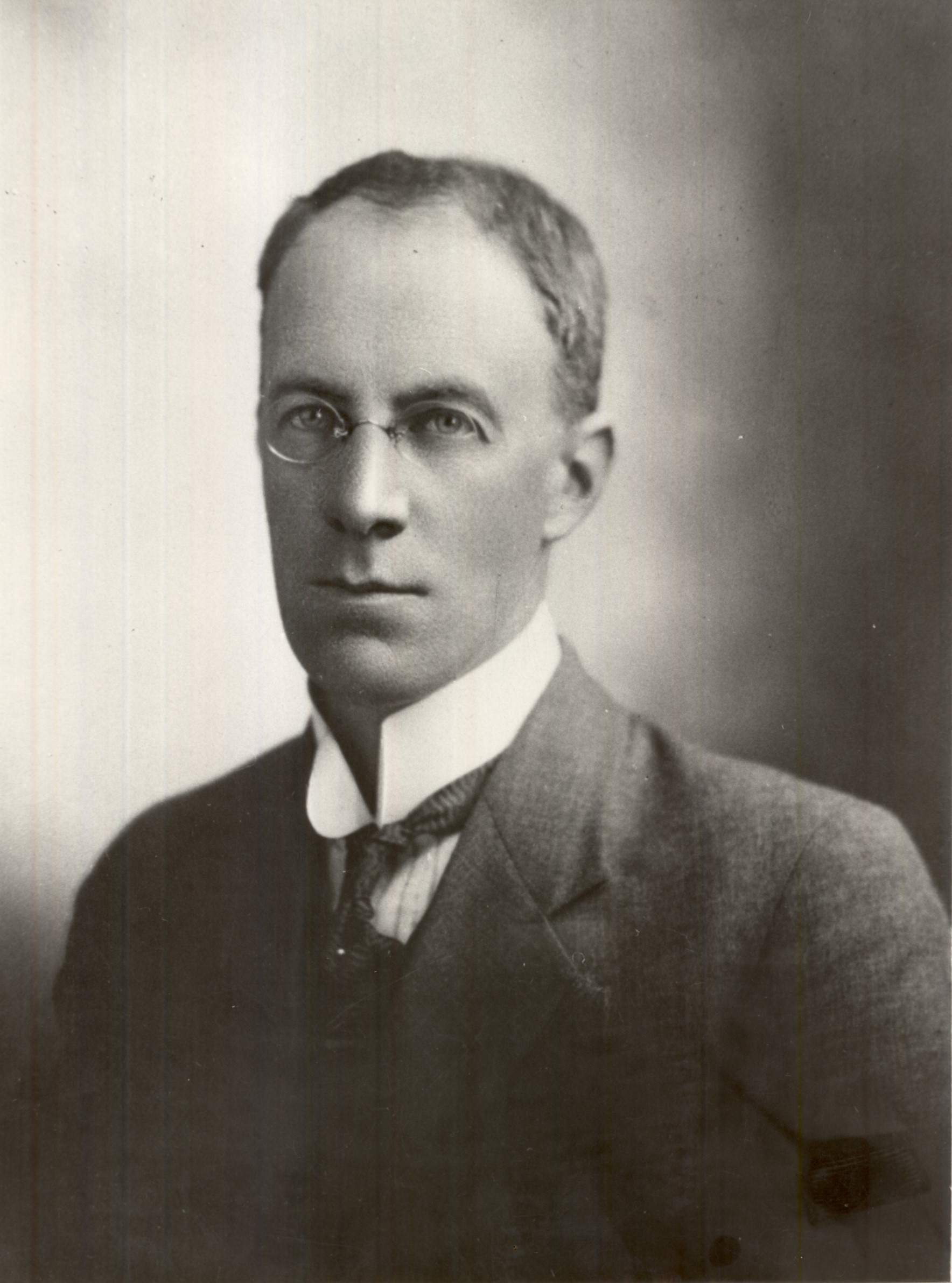
Stephen Spurling III in 1913, photo courtesy of Stephen Hiller.
Oddly, just about the only thing Spurling didn’t snap was a sack full of thylacine heads which he claimed to have seen at the Stanley Police Station in 1902. Forty-one years after the event, Spurling wrote that he watched ‘cattlemen from a station almost on the W coast [produce] two sacks of tigers’ heads (about 20 in number) and [receive] their reward’.[2] One-hundred-and-nineteen years after the event, this claim is hard to reconcile with the records of the government thylacine bounty. It adds a puzzle to the story of the so-called Woolnorth tigermen.
The Woolnorth tigermen
About 170 thylacines were killed at the Van Diemen’s Land (VDL Co) property of Woolnorth in the years 1871–1912, mostly by the company’s tigermen—a lurid title given to the Mount Cameron West stockmen. The tigermen had a standard job description for stockmen, receiving a low wage for looking after the stock, repairing fences, burning off the runs and helping to muster the sheep and cattle. They supplemented their income by hunting kangaroos, wallabies, pademelons, ringtail and brush possums. The only departure from the normal shepherd’s duty statement was keeping a line of snares across a neck of land at Green Point—now farming land at Marrawah—where the supposedly sheep-killing thylacines were thought to enter Woolnorth. The VDL Co paid their employees a bounty of 10 shillings for a dead thylacine, which was changed to match the government thylacine bounty of £1 for an adult and 10 shillings for a juvenile introduced in 1888. To make a government bounty application the tiger killer needed to present the skin at a police station, although sometimes thylacine heads sufficed for the whole skin.
It is not easy to work out how or even whether the Woolnorth tigermen generally collected the government thylacine bounty in addition to the VDL Co bounty. It is reasonable to think that the VDL Co would have encouraged its workers to do this, since doubling the payment doubled the incentive to kill the animal on Woolnorth. However, only two men are recorded as receiving a government thylacine bounty while acting as tigerman, Arthur Nicholls (6 adults, in 1889) and Ernest Warde (1 adult, 1 juvenile, in 1904).[3] This suggests that if Woolnorth tigermen and other staff received government thylacine bounties they did so through an intermediary who fronted up at the police station on their behalf.
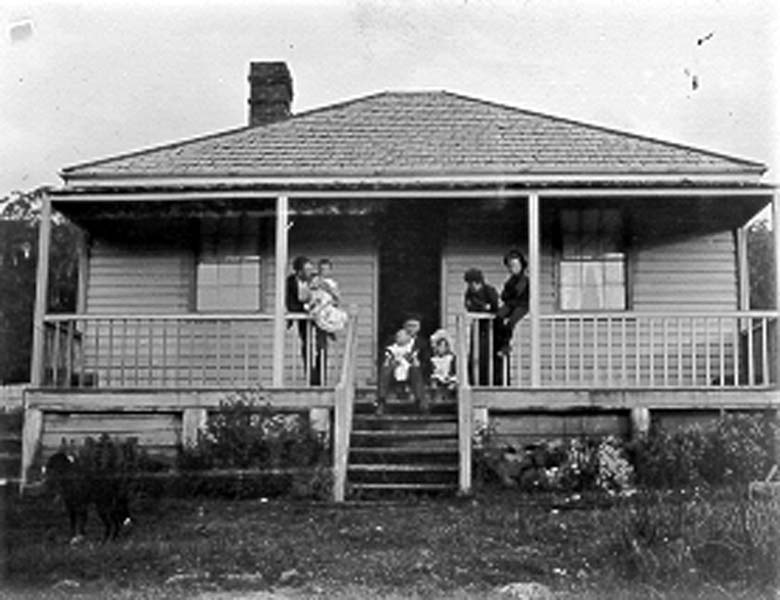
Charles Tasman Ford and family, PH30/1/6928 (Tasmanian Archives Office).
Charles Tasman Ford and William Bennett Collins
The most likely candidates for the job of Woolnorth proxy during the government bounty period 1888–1909 were CT (Charles Tasman) Ford and WB (William Bennett) Collins. In the years 1891–99 Ford, a mixed farmer (sheep cattle, pigs, poultry, potatoes, corn, barley, oats) based at Norwood, Forest, near Stanley, claimed 25 bounties (23 adults and 2 juveniles), placing him in the government tiger killer top ten.[4] If you include bounty payments that appear to have been wrongly recorded as CJ Ford (5 adults, 1896) and CF Ford (1 adult, 1897), his tally climbs to an even more impressive 29 adults and 2 juveniles—lodging him ahead of well-known tiger tacklers Joseph Clifford of The Marshes, Ansons River (27 adults and 2 juveniles) and Robert Stevenson of Blessington (26 adults).[5] After Ford’s death in September 1899, Stanley storekeeper Collins claimed bounties for 40 adults and 4 juveniles 1900–06, his successful bounty applications neatly dovetailing with those of Ford.[6]

William Bennett Collins (standing at back) and family, courtesy of Judy Hick.

WB Collins’ Stanley store, AV Chester photo, Weekly Courier, 25 February 1905, p.20.
Where did their combined 75 tigers come from? The biggest source of dead thylacines in the far north-west at this time was Woolnorth. Twenty-six adult tigers were taken at Woolnorth in the years 1891–99, and 44 adults in the years 1900–06, making 70 in all. Tables 1 and 2 show rough correlations between Woolnorth killings and government bounty claims made by Ford and Collins. Ford, for example, received 7 payments 1892–93, the same figure for Woolnorth, while in the years 1894–97 his figure was 13 adults and theirs 16. Similarly (see Table 2), Collins claimed 16 adult and 4 juvenile bounties in 1900, a year in which 22 adult tigers were killed at Woolnorth; while in 1901 the comparative figures were 17 and 9. (Some of the data for Woolnorth is skewed by being recorded only in annual statements, which makes it look as though most tigers were killed in December. This was not the case: the December figures represent killings over the course of the whole year.) Clearly the Woolnorth tigers did not represent all the bounties claimed by Ford and Collins, but likely these made up the majority of their claims.
Table 1: CT Ford bounty claims compared to Woolnorth tiger kills 1891–99
| CT Ford |
29 – 2 |
Woolnorth |
26 – 0 |
| 31 July 1891 |
2 adults |
|
|
| 21 July 1892 |
1 adult |
|
|
| 9 Jany 1893 |
1 adult |
31 Dec 1892 |
2 adults |
| 27 April 1893 |
2 adults |
|
|
| 5 May 1893 |
1 adult |
|
|
| 19 June 1893 |
1 adult |
|
|
| 24 July 1893 |
1 adult |
18 Dec 1893 |
5 adults |
| 23 Jany 1894 |
2 adults |
20 Dec 1894 |
3 adults |
| 24 Feby 1896 |
5 adults |
30 Dec 1895 |
4 adults |
| 5 March 1897 |
1 adult |
7 Jany 1896 |
2 adults |
| 22 Sept 1897 |
3 adults |
19 Dec 1896 |
3 adults |
| 4 Nov 1897 |
2 adults |
Dec 1897 |
4 adults |
| 1 Feby 1898 |
1 adult |
|
|
| 2 August 1898 |
2 adults |
Dec 1898 |
3 adults |
| 30 May 1899 |
1 adult |
|
|
| 30 Aug 1899 |
3 adults |
|
|
| 30 Aug 1899 |
2 young |
|
|
Table 2: WB Collins bounty claims compared to Woolnorth tiger kills 1900–12
| WB Collins |
40 – 4 |
Woolnorth |
44 |
| 27 Feby 1900 |
3 adults |
|
|
| 16 Aug 1900 |
5 adults |
|
|
| 3 Oct 1900 |
4 adults |
|
|
| 15 Nov 1900 |
4 adults, 4 young |
Dec 1900 |
22 adults |
| 13 Mar 1901 |
2 adults |
|
|
| 31 July 1901 |
7 adults |
|
|
| 28 Aug 1901 |
6 adults |
|
|
| 3 Oct 1901 |
1 adult |
Dec 1901 |
9 adults |
| 5 Nov 1901 |
1 adult |
Dec 1902 |
3 adults |
| 7 May 1903 |
2 adults |
Nov 1903 |
8 adults |
| 17 Nov 1903 |
4 adults |
1904 |
1 adult, 1 young (Warde) |
| 21 June 1906 |
1 adult |
1906 |
1 adult |
It would not have been difficult for Ford to act as a go-between for Woolnorth workers.[7] He had grazing land at Montagu and Marrawah/South Downs, east and south of Woolnorth respectively, and would have travelled via Woolnorth to reach the latter. He was also a supplier of cattle and other produce to Zeehan, a wheeler and dealer who bought up Circular Head produce to add to his consignments of livestock to the West Coast.[8] It would have been a simple thing for him on his way home from a Zeehan cattle drive to collect native animal skins and tiger skins/heads from the homestead at Woolnorth, presumably taking a commission for himself in his role as intermediary.
Of course that is not the only possible explanation for Ford’s bounty payments. His brothers Henry Flinders (Harry) Ford (three adults) and William Wilbraham Ford (6 adults) both claimed thylacine bounties. They had a cattle run at Sandy Cape, while William had another station at Whales Head (Temma) on the West Coast stock route.[9] It is possible that all the Ford government thylacine bounty payments represented tigers killed on their own grazing runs and/or in the course of West Coast cattle drives. CT Ford did, after all, take up land at Green Point, the place where the VDL Co killed most of its tigers in the nineteenth century. However, if the Fords killed a lot of tigers on their own properties or during cattle drives you would expect to see some evidence for it, such as in newspaper reports or letters. The Fords were, after all, not only VDL Co manager James Norton Smith’s in-laws, but variously his tenants, neighbours and fellow cattlemen. No evidence has been found in VDL Co correspondence. Oddly, when CT Ford shot himself at home in 1899, it was reported to police by his supposed employee George Wainwright—the same name as the Woolnorth tigerman of that time.[10] Perhaps this was the tigerman’s son George Wainwright junior, who would then have been about sixteen years old, and if so it shows that tigerman and presumed proxy bounty collector knew each other.
For all his 44 bounty claims, storekeeper WB Collins possibly never saw a living thylacine, let alone killed one. After Ford’s death, Collins appears to have established an on-going relationship with Woolnorth, being paid for three bounties in February 1900 before his store even opened for business. The VDL Co correspondence contains plenty of evidence that Collins dealt regularly with Woolnorth as a supplier and skins dealer.
The puzzle of Spurling’s sack of tiger heads
The only problem is Spurling. His claim about the 20 tiger heads being presented to the Stanley Police as a bounty claim doesn’t make a lot of sense. There is no record of such an event in the Stanley Police Station books, although, admittedly, tiger bounty payments rarely turn up in police station duty books or daily records of crime occurrences.[11] Still, 20 bounty claims presented at once would constitute a noteworthy event. The ‘almost W coast’ cattle station to which Spurling referred can only have been Woolnorth or a farm south of there, but his recollection seems wildly inaccurate..
If we assume Spurling got the year right, 1902, we can try to fix on an approximate date for his sack of tiger heads. Spurling photos of Stanley appeared in the Weekly Courier newspaper on 26 April 1902. If we assume that taking these photos provided the occasion for the photographer to meet the tiger heads, we are confined to government bounty payments for the first four months of that year. Less than 20 bounties were paid across Tasmania during that time, and there were no bulk payments of the kind described by Spurling—nor did any bulk payments occur at any time during the year 1902.
Did Spurling get the year wrong? If the 20 heads came from Woolnorth and were supplied in bulk, the time was probably late 1900, the first year in decades in which more than 20 tigers were taken there. Did Spurling see someone from Collins’ store bring in heads from Woolnorth? Not even that seems likely. In February 1900 Collins collected bounties for three adult thylacines; another 5 adults followed in July; in September he collected on another 4; and in October he presented 4 adults and 4 cubs: 20 animals in all, spread over a period of eight months, not in one hit.[12] Saving those 20 heads secured over a period of months for presentation in one hit would be a—frankly—disgusting task given their inevitable state of putrefaction. Spurling’s sack of heads didn’t represent Collins or Woolnorth. No one—no bounty applicant from any part of Tasmania, let alone a group of Woolnorth employees—was ever paid 20 bounties in one hit. The basis of his claim remains a mystery.
[1] See Nic Haygarth, Wonderstruck: treasuring Tasmania’s caves and karst, Forty South Publishing, Hobart, 2015, pp.63–69.
[2] Stephen Spurling III, ‘The Tasmanian tiger or marsupial wolf Thylacinus cynocephalus’, Journal of the Bengal Natural History Society, vol.XVIII, no,2, October 1943, p.56.
[3] Nicholls: bounties no.289, 14 January 1889, p.127 (4 adults); and no.126, 29 April 1889, p.133 (2 adults), LSD247/1/1. Warde: bounty no.190, 20 October 1904 (1 adult and 1 juvenile), LSD247/1/2 (TAHO).
[4] Bounties no.365, 31 July 1891 (2 adults); no.204, 21 July 1892, LSD247/1/1; no.402, 9 January 1893; no.71, 27 April 1893 (2 adults); no.91, 5 May 1893; no.125, 19 June 1893; no.183, 24 July 1893, no.4, 23 January 1894 (2 adults); no.239, 22 September 1897 (3 adults, ‘August 2’); no.276, 4 November 1897 (2 adults, ’27 October’); no.379, 1 February 1898 (‘4 December’); no.191, 2 August 1898 (2 adults, ‘7 July’); no.158, 30 May 1899 (’26 May’); no.253, 30 August 1899 (3 adults, ’24 August’); no.254, 30 August 1899 (2 juveniles, ‘24 August’), LSD247/1/2 (TAHO).
[5] Bounties no.304, 24 February 1896 (5 adults); and no.37, 5 March 1897, LSD247/1/2 (TAHO).
[6] Bounties no.43, 27 February 1900 (3 adults, ’22 February’); no.250, 16 August 1900 (5 adults, ’26 July’); no.316, 3 October 1900 (4 adults, ’27 September’); no.398, 15 November 1900 (4 adults and 4 juveniles, ’28 October’); no.79, 13 March 1901 (2 adults, ’28 February’); no.340, 31 July 1901 (7 adults, ’25 July’); no.393, 28 August 1901 (6 adults, ‘2/3 August’); no.448, 3 October 1901 (’26 September’); no.509, 5 November 1901 (’24 October 1901’); no.218, 7 May 1903 (2 adults, ’24 April’); no.724, 17 November 1903 (4 adults); no.581, 21 June 1906, LSD247/1/2 (TAHO).
[7] Woolnorth farm journals, VDL277/1/1–33 (TAHO). The Woolnorth figure for 1900–06 excludes one adult and one juvenile killed by Ernest Warde and for which he claimed the government bounty payment himself (bounty no.190, 20 October 1904, LSD247/1/2 [TAHO]).
[8] ‘Circular Head harvest prospects’, Wellington Times and Agricultural and Mining Gazette, 19 January 1895, p.2.
[9] Wise’s Tasmanian Post Office directory, 1898, p.184; 1899, p.305.
[10] 10 September 1899, Daily record of crime occurrences, Stanley Police Station, POL93/1/1 (TAHO).
[11] Stanley Police Station duty book, POL92/1/1; Daily record of crime occurrences, POL93/1/1 (TAHO). Daily records of crime occurrences often include information not of a criminal nature.
[12] Bounties no.43, 22 February 1900 (three adults); no.250, 16 August 1900 (five adults); no.316, 27 September 1900 (four adults); and no.398, 28 October 1900 (four adults and four juveniles), LSD247/1/2 (TAHO).
by Nic Haygarth | 22/10/20 | Circular Head history, Story of the thylacine
By the 1890s farmers like Joseph Clifford and Robert Stevenson were effectively adding Tasmanian tiger farming to their portfolios of raising stock, growing crops and hunting. Since thylacines appeared on their property, they made a conscious effort to catch them alive in a footer snare or pit rather than dead in a necker snare. A tiger grew no valuable wool, but in 1890 a live wether might fetch 13 shillings, compared to £6 for an adult thylacine delivered to Sydney.[1] A dead adult thylacine, on the other hand, was worth only £1 under the government bounty scheme.
The problem with these special efforts to catch tigers alive was that hunters only had a certain amount of control over what animals ended up in their snares or pits. Twentieth-century hunters often complained about city regulators who thought it feasible to close the season on brush possum but open it for wallabies and pademelons. Inevitably, hunters caught some brush possum in their wallaby and pademelon snares during the course of the season, which could land them a hefty fine in court unless they destroyed the precious but unlawful skins.[2] John Pearce junior in the upper Derwent district claimed that he and his brothers caught seventeen tigers in ‘special neck snares’ set alongside their kangaroo snares.[3] How did the tigers recognise the ‘special neck snares’ provided for their specific use? All you could do was vary the height of the necker snare to catch the desired animal’s head as it walked. Too bad if something else stuck its head in the noose. Wombats, for example, were a hazard. Gustav Weindorfer of Cradle Valley set snares at the right height to catch Bennett’s wallabies by the neck, but also caught wombats in them.[4] Wombats were good for ‘badger’ stew and for hearth mats but the skins had no value. Robert Stevenson of Aplico, Blessington, caught wombats alive in his tiger pits—which they then set about destroying by burrowing their way out.[5]
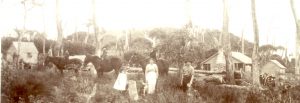
George Wainwright senior, Matilda Wainwright and children at Mount Cameron West (Preminghana) c1900. Courtesy of Kath Medwin.
These problems aside, it seems odd that the pragmatic Van Diemen’s Land Company (VDL Co), which later added fur hunting to its income stream, didn’t cotton on to the live tiger trade. They could have followed the example of George Wainwright senior, who sold a Woolnorth tiger to Fitzgerald’s Circus in 1896.[6] In 1900, for example, 22 thylacines were killed on Woolnorth, a potential income of more than £100 had the animals been taken alive. Even when, later, four living Woolnorth tigers were sold, the money stayed with the employees, with the VDL Co not even taking a commission. (It should be noted that four young tigers caught by Walter Pinkard on Woolnorth in 1901 were not accounted for in bounty payments.[7] It is possible that they were sold alive—but there are no records of a sale or even correspondence about the animals. Their fate is unknown.)
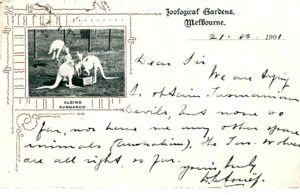
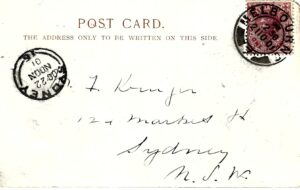
William Le Souef to Kruger, 22 October 1901: ‘The Tasmanian Wolves are all
right, so far’. Did he get them from Woolnorth? Postcard courtesy of Mike Simco.
The VDL Co’s failure to exploit the live trade for its perceived arch enemy can possibly be explained by the tunnel vision of its directors and departing Tasmanian agent and the inexperience of his successor. James Norton Smith resigned as local manager in 1902. His replacement, Scotsman Andrew Kidd (AK) McGaw, harnessed Norton Smith’s 33-year corporate knowledge by re-engaging him as farm manager. It would not have been easy for McGaw to learn the ropes in a new country, among business associates cultivated by his predecessor, and the re-engagement of Norton Smith as his second allowed him to transition into the manager position. As would be expected, McGaw stamped his authority on the agency by criticising some of Norton Smith’s policies and distancing himself from them.[8] Ahead of Ernest Warde’s engagement as ‘tigerman’, the VDL Co’s shepherd at Mount Cameron West, he scrapped Norton Smith’s recent bounty incentive scheme of £2 for a tiger killed by a man out hunting with dogs.
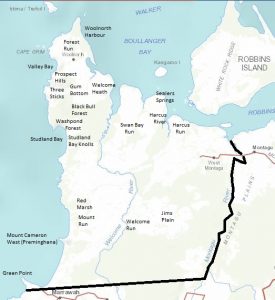
Woolnorth, showing main property features and the original boundary. Base map courtesy of DPIPWE.
After Warde’s departure in 1905, the tiger snares at Mount Cameron and Studland Bay were checked intermittently. Woolnorth overseer Thomas Lovell killed a tiger at Studland Bay in 1906, but the number of tigers and dogs reported on the property was now negligible.[9] This reflected the statewide situation, with only eighteen government thylacine bounties being paid in 1907, and only thirteen in 1908.[10]
However, the value of live tigers continued to climb as they became rarer. The first documented approach to the VDL Co for live tigers came in July 1902 from AS Le Souef of the Zoological Gardens in Melbourne, who offered £8 for a pair of adults and £5 for a pair of juveniles. He also wanted devils and tiger cats, in response to which George Wainwright junior supplied two tiger cats (spotted quolls, Dasyurus maculatus).[11] Given the tiger’s reputation as a sheep killer, native animal farming might have been a hard sell to the directors, and the company continued to use necker snares which were generally fatal to thylacines. What price would it take to change that behaviour? In July 1908 McGaw read a newspaper advertisement:
‘WANTED—Five Tasmanian tigers, handsome price for good specimens. Apply Beaumaris, Hobart.’[12]
He discovered that the proprietor of the private Beaumaris Zoo at Battery Point, Mary Grant Roberts, wanted a pair of living tigers immediately to freight to the London Zoo.[13] The Orient steamer Ortona was departing for London at the end of the month. She offered McGaw £10 for a living, uninjured pair of adults. Roberts hoped to secure the tiger caught recently by George Tripp at Watery Plains, but felt that she was competing for live captures with William McGowan of the City Park Zoo, Launceston, who advertised in the same month.[14] Eroni Brothers Circus was also in the market for living tigers.[15]
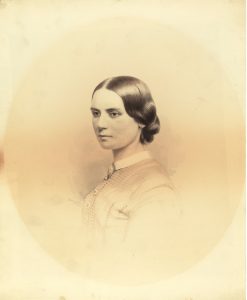
A young Mary Grant Roberts, from NS823/1/69 (Tasmanian Archive and Heritage Office).
Almost as Roberts made her offer, George Wainwright junior tracked a tiger at Mount Cameron West, but it evaded capture.[16] In the meantime Roberts was able to secure her first thylacine from the Dee River.[17]
Almost a year passed before the chance arose for the VDL Co do business, when in May 1909 Wainwright retrieved a three-quarters-grown male tiger uninjured from a necker snare.[18] Perhaps not appreciating the tiger’s youth, Roberts offered £5 plus the rail freight from either Burnie or Launceston. She wanted the animal delivered to her in Hobart within ten days in order to ship it to the London Zoo on the Persic. It would thereby replace one which had died of heat exhaustion in transit to the same destination a few months earlier.[19]
However, the overseer of a remote stock station could not meet that deadline. The delay came with a bonus—the capture of three more members of the first tiger’s family, his sisters and mother.[20] Bob Wainwright recalled his stepfather Thomas Lovell and brother George placing the animals in a cage. There was also a familiar story of tigers refusing to eat dead game: ‘They had to catch a live wallaby and throw it in, alive, and then they [the thylacines] killed it’.[21] With McGaw continuing to act as intermediary between buyer and supplier, a price of £15 was settled on for the family of four.[22]
Roberts and McGaw communicated as social equals, but their social inferiors—hunters, stockmen and an overseer—were not named in their correspondence. This made for frustrating reading when Roberts discussed hunters (‘the man’) with whom she was dealing over live tigers. She had been expecting to receive two young tigers from a Hamilton hunter for her own zoo, but these had now died, causing her to reconsider her plans for the Woolnorth family.[23]
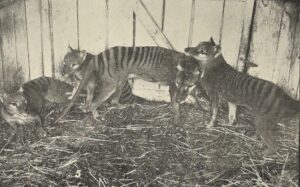
The mother thylacine (centre) and her three young captured at Woolnorth in 1909. W Williamson photo from the Tasmanian Mail, 25 May 1916, p.18.
It wasn’t until the first week in July 1909 that the auxiliary ketch Gladys bore the crate of thylacines to Burnie, where they began the train journey to Hobart.[24] A week later they were said to be thriving in captivity.[25] Roberts was so pleased with the animals’ progress that after eight months she sent a postal order to Lovell and Wainwright as a mark of appreciation. She was impressed with the mother’s devotion to her young, believing that the death of the two Hamilton cubs was attributable to their mother’s absence.[26] However, money was becoming a concern. Buying all the tigers’ feed from a butcher was expensive, and when she received a potentially lucrative order for a tiger from a New York Zoo, she found the cost of insuring the animal over such a long journey prohibitive. On 1 March 1910 she ‘very reluctantly’ broke up the family group by dispatching the young male to the London Zoo. ‘I am keeping on the two [other juveniles]’, she wrote, ‘in the hope that they may breed, and the mother all along has been very happy with the three young ones’.[27]
Roberts was now offering £10 per adult thylacine—but there was none to sell at Woolnorth. Seventeen months later she paid Power £12 10s for his large tiger from Tyenna, and scored £30 shipping to London the last of the three young from the 1909 family group.[28] Her tiger breeding program was over, probably defeated by economics—but what might have been the rewards for perseverance? Perhaps she would have been the greatest tiger farmer of all.
[1] See, for example, ‘Commercial’, Mercury, 5 August 1890, p.2; Sarah Mitchell diary, 9 June 1890, RS32/20, Royal Society Collection (University of Tasmania Archives).
[2] See, for example, ‘Trappers fined’, Advocate, 22 October 1943, p.4.
[3] ‘Direct communication with the west coast initiated’, Mercury, 1 September 1932, p.12.
[4] G Weindorfer and G Francis, ‘Wild life in Tasmania’, Journal of the Victorian Naturalists Society, vol.36, March 1920, p.159.
[5] Lewis Stevenson, interviewed by Bob Brown, 1 December 1972 (QVMAG).
[6] ‘Circular Head notes’, Wellington Times and Agricultural and Mining Gazette, 25 June 1896, p.2.
[7] Walter Pinkard to James Norton Smith, 19 July 1901, VDL22/1/27 (TAHO).
[8] In Outward Despatch no.46, 4 January 1904, p.366, McGaw criticised Norton Smith for not doing more to arrest the encroachment of sand at Studland Bay and Mount Cameron (VDL7/1/13).
[9] Woolnorth farm diary, 30 September 1906 (VDL277/1/34). This VDL Co bounty was not paid until the following year (December 1907, p.95, VDL129/1/4). C Wilson was paid for killing two dogs found worrying sheep in 1906 (December 1906, p.58, VDL129/1/4 (TAHO).
[10] See thylacine bounty payment records in LSD247/1/3 (TAHO).
[11] AS Le Souef to James Norton Smith, 11 July 1902; Walter Pinkard to James Norton Smith, 4 August 1902, VDL22/1/28 (TAHO).
[12] ‘Wanted’, North Western Advocate and the Emu Bay Times, 1 July 1908, p.3.
[13] For Roberts, see Robert Paddle, ‘The most photographed of thylacines: Mary Roberts’ Tyenna male—including a response to Freeman (2005) and a farewell to Laird (1968)’, Australian Zoologist, vol.34, no.4, January 2008, pp.459–70.
[14] In ‘Wanted to buy’, Mercury, 18 July 1908, p.2, McGowan asked for tigers ‘dead or alive’. He had also advertised for ‘tigers … good, sound specimens, high price; also 2 or 3 dead or damaged specimens’ in the previous year (‘Wanted’, Mercury, 21 June 1907, p.2). George Tripp’s tiger must have died before it could be sold alive, since he claimed a government bounty for it (no.35, 25 July 1908, LSD247/1/3 [TAHO]).
[15] See, for example, ‘Wanted’, North Western Advocate and the Emu Bay Times, 7 March 1908, p.6.
[16] Thomas Lovell to AK McGaw, 17 July 1908, VDL22/1/34 (TAHO).
[17] ‘The Tasmanian tiger’, Mercury, 7 October 1908, p.4.
[18] Thomas Lovell to AK McGaw, 24 May 1909, VDL22/135 (TAHO). This thylacine was originally thought to be a young female, but McGaw later stated that it was a young male.
[19] Mary G Roberts to AK McGaw, 31 May 1909, VDL22/1/35 (TAHO).
[20] Thomas Lovell to AK McGaw, 1 June 1909, VDL22/1/35 (TAHO).
[21] Bob Wainwright, 86 years old, interviewed in Launceston, 27 October 1980.
[22] AK McGaw to Mary G Roberts, 9 June 1909, VDL52/1/29; Mary G Roberts to AK McGaw, 10 June 1909, VDL22/1/35 (TAHO).
[23] Mary G Roberts to AK McGaw, 21 June 1909, VDL22/1/35 (TAHO).
[24] AK McGaw to Mary G Roberts, 7 July 1909, VDL52/1/29 (TAHO); ‘Stanley’, North Western Advocate and the Emu Bay Times, 6 July 1909, p.2.
[25] W Roberts to AK McGaw, 15 July 1909, VDL22/1/35 (TAHO).
[26] In May 1912 she received two young tigers from buyer EJ Sidebottom in Launceston, paying him £20 in the belief that they were adults. They died three days later (Mary Grant Roberts diary, 6, 7 and 10 May 1912, NS823/1/8 [TAHO]).
[27] Mary G Roberts to AK McGaw, 14 March 1910, VDL22/1/36 (TAHO).
[28] Mary Grant Roberts diary, 12 August, 26 September and 24 December 1911, NS823/1/8 (TAHO).
by Nic Haygarth | 29/12/16 | Circular Head history, Story of the thylacine, Tasmanian high country history
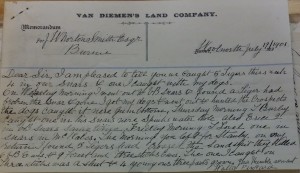
Tigers to the left, tigers to the right … VDL Co stockman Walter Pinkard reports from the thick of the Woolnorth tiger action 8 June 1901. From VDL22-1-32 (TAHO).
How do you stigmatise an animal? Try branding. The change from ‘hyena’ to ‘tiger’, as the common descriptor for the thylacine, was a major step in its reinvention as a sheep killer. Both ‘tiger’ and ‘hyena’ were used commonly to describe the thylacine during much of the nineteenth century, with ‘tiger’ only becoming the dominant term late in that century and into the twentieth century. For example, the records of the Van Diemen’s Land Company (VDL Co) show that the company’s local officers used ‘hyena’ almost universally to describe the thylacine during the company’s first period of farming its Woolnorth property, in the years 1827–51—whereas later they went exclusively with ‘tiger’.
The stripes on the thylacine’s back presumably prompted the original attributions of the names ‘tiger’ and ‘hyena’, by Robert Knopwood and CH Jeffreys respectively.[1] The Bengal tiger (Panthera tigris tigris) and the striped hyena (Hyaena hyaena) were mentioned regularly in nineteenth-century newspaper items about life in the British Raj, which some foreign-born Tasmanians had also visited. Tigers, leopards, cheetahs, wolves and, less often, hyenas, preyed on stock and sometimes people in India. Government rewards were offered there for killing tigers. While the fearsome tiger was the favourite ‘sport’ of Indian big game hunters, the hyena, unlike its some-time Tasmanian namesake, was not the primary carnivore in the Bengali ecology. It was sometimes reported to be ‘cowardly’, ‘skulking’ and lacking in the fight desired by the game hunter.[2]
Likewise, the thylacine was also often described as ‘cowardly’ in its alleged sheep predations.[3] By the 1870s and 1880s, however, when the profitability of the wool industry was declining, those employed in the industry seem to have used the term ‘tiger’ almost universally to describe the thylacine. Perhaps shepherds preferred ‘tiger’ because it glamorised their profession, introducing an element of danger and likening them to the big game hunters of India. The way in which some thylacine killers made trophies of their kills and were photographed with these suggests identification with big game hunting.[4] By the same token, dubbing the thylacine a ‘tiger’ provided a potential scapegoat for sheep losses, enabling the shepherd to shift the blame for his own poor performance on to what may henceforth be perceived as a dangerous predator. Wool-growers wanting to eliminate the thylacine would also be keen to cast it as a dangerous predator. John Lyne, the east coast wool-grower who led the campaign for a government thylacine bounty, referred to the animal as a ‘tiger’ but also as a ‘dingo’, thereby equating the thylacine with the well-known mainland Australian sheep predator.[5] In 1887 ‘Tiger Lyne’s campaign was mocked to the effect that
‘the jungles of India do not furnish anything like the terrors that our own east coast does in the matter of wild beasts of the most ferocious kind. According to ‘Tiger Lyne’, these dreadful animals [thylacines] may be seen in their hundreds stealthily sneaking along, seeking whom they may devour …’[6]
The VDL Co correspondence records show that the company’s local agent James Norton Smith also originally described the thylacine as a ‘hyena’. He appears to have adopted ‘tiger’ as a descriptor in 1872 after his Woolnorth overseer, Cole, used the term in a letter to him. James Wilson, Woolnorth overseer 1874–98, also used the term ‘tiger’ exclusively, and after 1876 Norton Smith followed suit. The term ‘hyena’ was not used in any correspondence written or compiled by VDL Co staff, in Woolnorth farm journal records or Woolnorth accounting records in the years 1877–99. While Norton Smith occasionally used the term ‘hyena’ in the years following Wilson’s retirement from Woolnorth, ‘tiger’ remained his preferred term and this continued to be used exclusively at Woolnorth.
Theophilus Jones: thylacine prosecutor
As Robert Paddle and others have suggested, pastoralists generally blamed the thylacine as well as the rabbit for their declining political power and wealth.[7] One of the greatest prosecutors of the thylacine at this time was Theophilus Jones. In 1877–78 and 1883–85 two young British journalists toured Tasmania writing serialised newspaper accounts of its districts. Since both were newcomers, with limited knowledge of the colony, they could be expected to repeat unquestioningly much of what they were told. The first of these writers, E Richall Richardson, travelled all the populated regions of Tasmania except the far north-west and Woolnorth. On the east coast, Richardson interviewed woolgrowers, including John Lyne, the MHA for Glamorgan who a decade later would petition to establish the thylacine bounty. Richardson’s only comment upon the thylacine as a sheep killer or any kind of nuisance in his 92-part series was not on the east coast or in the Midlands, but in reference to the twice-yearly visits of graziers to their Central Plateau stock runs:
‘If when the master comes up, and there is a deficit in the flock, the rule is ‘blame the tiger’. The native tiger is a kind of scape-goat amongst shepherds in Tasmania, as the dingo is with shepherds in Queensland; or as ‘the cat’ is with housemaids and careless servants all over the world. ‘It was the cat, ma’am, as broke the sugar-basin’; and ‘It was the tigers, sir, who ate the sheep’.[8]
Theophilus Jones, in his 99-part series written in the years 1883–85, told a different tale. By this time, only half a decade since Richardson wrote, the wool industry had declined markedly. The first ‘stock protection’ association, that is, a locally subscribed thylacine bounty scheme, was formed at Buckland on the east coast in August 1884 while Jones was touring the area.[9]
Jones’ circumstances were different to the earlier writer’s. Although travelling in poverty, Richardson was a single man with no commitments. Jones, on the other hand, was trying desperately to support a wife and large family. While travelling Tasmania as a newspaper correspondent, he doubled as an Australian Mutual Provident (AMP) assurance salesman. Much more than Richardson, Jones concentrated on populated areas where he might sell assurance and find well-to-do patrons. He not only visited Woolnorth but practically every large grazier in the colony, and he flattered men who were in a position to financially benefit him. Whether currying favour or being merely ignorant of the truth, it is not then surprising to find Jones spouting woolgrowers’ vituperative against the thylacine. Henry, John and William Lyne appear to have fed Jones a litany of almost six decades of warfare with Aborigines and the wildlife, as if these were age-old predators: ‘Blacks and tigers made the life of a young shepherd one of continued mental strain’.[10] For Jones the tiger was generally the biggest killer of sheep, followed by the devil and the ‘eaglehawk’. The thylacine had ‘massive’ jaws, ‘serrated’ teeth and a powerful body like that of a kangaroo dog.[11] It was ‘a great coward’, savaging lambs but refusing battle with man or dog.[12] Jones applauded the stock protection association, hoping that it would reduce eagles and tigers ‘to the last specimen’.[13] That is, drive them to extinction.
Jones had already visited Woolnorth. He found that, like his predecessors, tigerman Charlie Williams kept ‘trophies’ at Mount Cameron, his prize being a thylacine skin 2.3 metres long.[14]
Like Williams, the government was actually more interested in possums. It had cited increased hunting, in response to high skin prices, as a reason to introduce the Game Protection Amendment Act (1884), which protected all kinds of possum during the summer, allowing open season from April to July inclusive. During debate about the bill in the House of Assembly, James Dooley ‘likened the sympathy for the native animals to that which was excited in favour of the native race’, to which MHA for Sorell, James Gray, responded that ‘the only resemblance between the natives and the opossums were that they were both black. (Laughter.)’[15]
It was also Gray who in 1885 asserted the ‘necessity of something being done to stop the ravages of the native tiger in the pastoral districts of the colony …’.[16] John Lyne took up this stock protection measure: a £1 per head thylacine bounty operated from 1888 to 1909. About 2200 bounties were paid across Tasmania, helping to drive the animal towards extinction. Bounties were paid by the Colonial Treasurer upon thylacine carcasses being presented to local police magistrates or wardens.
Woolnorth was a remote settlement with challenges faced by few wool-growing properties. Distance from towns, doctors and schools was probably one reason that it was so difficult to find and keep a reliable man to work at Mount Cameron West in particular. Time and time again James Wilson’s farm journals record the Mount Cameron West shepherd’s monthly visits to the main farm at Woolnorth to get supplies and return with them to his own hut: ‘Tigerman came down’ and ‘Tiger went home’. ‘Tigerman’, which carries the implication of being a dedicated thylacine killer, may have been coined to glamorise the position in order to attract staff. It and the general use of the term ‘tiger’ at Woolnorth may also indicate that the overseer, his stockman and farm hands wanted to shift the blame for sheep losses on the property.
Table 3: Occurrences of various names for the thylacine in Tasmanian newspapers for the years 1816–1954 (in both text and advertising), taken from the Trove digital newspaper database 22 December 2016
| NAME |
1816–87 |
1888–1909 |
1910–54 |
TOTAL |
| Tasmanian tiger |
141 (84–57) |
96 (64–32) |
434 (420–14) |
671 (568–103) |
| Native tiger |
326 (199–127) |
197 (186–11) |
88 (88–0) |
611 (473–138) |
| Tasmanian native tiger |
5 (5–0) |
0 (0–0) |
7 (7–0) |
12 (12–0) |
| Thylacine/thylacinus |
43 (43–0) |
20 (20–0) |
93 (91–2) |
156 (154–2) |
| Hyena/native hyena/opossum hyena |
165 (107–58) |
46 (39–7) |
84 (77–7) |
295 (223–72) |
| Dog-faced opossum |
1 (1–0) |
0 (0–0) |
0 (0–0) |
1 (1–0) |
| Tasmanian wolf |
9 (3–6) |
11 (11–0) |
97 (97–0) |
117 (111–6) |
| Marsupial wolf |
4 (4–0) |
6 (6–0) |
74 (74–0) |
84 (84–0) |
| Tiger wolf |
7 (7–0) |
3 (3–0) |
3 (3–0) |
13 (13–0) |
| Native wolf/native wolf-dog |
5 (5–0) |
0 (0–0) |
5 (5–0) |
10 (10–0) |
| Zebra wolf |
5 (5–0) |
6 (6–0) |
2 (2–0) |
13 (13–0) |
| Tasmanian tiger wolf |
1 (1–0) |
0 (0–0) |
0 (0–0) |
1 (1–0)[17] |
In her book Paper tiger: how pictures shaped the thylacine, Carol Freeman stated that ‘Tasmanian wolf’ and ‘marsupial wolf’ were the principal names given to the thylacine in the zoological world until well into the twentieth century, described how in the period from the 1870s to the 1890s ‘wolf-like’ visual images of the species predominated in natural history literature, and speculated that illustrations of this kind, repeated in mass-produced Australian newspapers in 1884, 1885 and 1899, ‘influenced perceptions close to the habitat of the thylacine and encouraged government extermination policies’.[18]
The National Library of Australia’s Trove digital newspaper database allows us to test the idea that the depiction of the thylacine as a ‘wolf’ or as ‘wolf-like’ had any traction in Tasmania. Unlike the inter-colonial illustrated newspapers to which Freeman referred—Australian Graphic (1884), Illustrated Australian News (1885) and Town and Country Journal (1899)—the Trove search represented by Table 3 is restricted to 88 Tasmanian newspaper titles, 23 of which published during at least part of the period of the Tasmanian government thylacine bounty 1888–1909. More than any other type of publication, the Tasmanian newspapers are likely to contain the language of ordinary Tasmanians, expressed either by journalists, newspaper correspondents or by themselves in letters to the editor—and they were more likely than any other form of publication to be read by and contributed to by graziers, legislators and hunter-stockmen involved in killing thylacines. Some of these newspapers carried occasional lithographed or engraved images, but the search does not include the two best-known Tasmanian illustrated newspapers, the Weekly Courier (1901–35) and the Tasmanian Mail/Illustrated Tasmanian Mail (1877–1935), which (in December 2016) were yet to be digitised for the Trove database. Trove coverage of Tasmanian newspapers begins with the Hobart Town Gazette and Southern Reporter in 1816 and goes no later than 1954 except in a few cases.
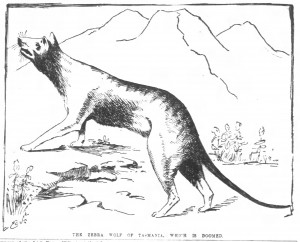
The Tasmanian ‘zebra wolf’, from the San Francisco Chronicle, 18 February 1896, p.6.
The Trove search suggests that in the period 1888–1909 the terms ‘native tiger’ (197 hits) and ‘Tasmanian tiger’ (96 hits) were much more widely used by the general public in Tasmania that any permutation of ‘wolf’ (26 hits altogether), and that ‘hyena’ (46 hits) was also more popular than ‘wolf’. While the 1884 issue of Australian Graphic which contained the illustration of the ‘Tasmanian zebra wolf’ is not included in the Trove search, it did pick up a description of that issue of the newspaper by the editor of the Mercury. Clearly he was not profoundly influenced by the engraving of the thylacine:
‘The illustrations are fairly good, excepting those which are apparently intended to be amusing; these amuse only by their extreme absurdity. There is a cut representing, what is termed, a Tasmanian zebra wolf. It is about as true to nature as the pictures exhibited outside a travelling menagerie’.[19]

The ‘Tasmanian wolf’ as a sheep devourer in 1947, when the term ‘wolf’ had gained some popular usage: from Hotch Potch (the magazine of the Electrolytic Zinc Company of Australasia), October 1947, vol.4, p.2 (TAHO).
The names ‘Tasmanian wolf’ (97 hits) and ‘marsupial wolf’ (74 hits) only gained traction in Tasmanian newspapers in the period (1910–54) when the thylacine was clearly disappearing or virtually extinct, that is, when the scientific and zoological community entered the popular press in its desperate search for a remnant thylacine population. This is also the period in which the Latin scientific name for the animal, thylacine, thylacinus (93 hits) occurred much more frequently in the Tasmanian press. However, even in this period, ‘tiger’ (529 hits) remained easily the predominant descriptor for the thylacine. The fact that the thylacine received more attention in the press during the years when it could not be found than when it could speaks for itself, although of course many more newspapers were published in the first half of the twentieth century than in the nineteenth.
[1] Eric Guiler and Philippe Godard, Tasmanian tiger: a lesson to be learnt, Abrolhos Publishing, Perth, 1998, p.15.
[2] ‘Pigsticking in India’, Launceston Examiner, 29 March 1897, p.3; ‘Shikalee’, ‘Wild sport in India’, Launceston Examiner, 24 July 1897, p.2.
[3] See, for example’, ‘Royal Society of Tasmania’, Courier, 16 June 1858, p.2; or ‘Town talk and table chat’, Cornwall Chronicle, 27 March 1867, p.4.
[4] See, for example, [Theophilus Jones], ‘Through Tasmania: no.35’, Mercury, 26 April 1884, supplement, p.1.
[5] See, for example, ‘Parliament’, Launceston Examiner, 1 October 1886, p.3.
[6] Tasmanian Mail, 3 September 1887; cited by Robert Paddle, The last Tasmanian tiger: the history and extinction of the thylacine, Cambridge University Press, Cambridge, UK, 2000, p.161.
[7] See Robert Paddle, The last Tasmanian tiger.
[8] E Richall Richardson, ‘Tour through Tasmania: no.89: cattle branding’, Tasmanian Tribune, 14 March 1878, p.3.
[9] ‘Buckland’, Mercury, 15 August 1884, p.3.
[10] Theophilus Jones, ‘Through Tasmania: no.61’, Mercury, 8 November 1884, supplement, p.1.
[11] Theophilus Jones, ‘Through Tasmania: no.49’, Mercury, 26 July 1884, p.2.
[12] Theophilus Jones, ‘Through Tasmania: no.35’, Mercury, 26 April 1884, supplement, p.1.
[13] Theophilus Jones, ‘Through Tasmania: no.56’, Mercury, 20 September 1884, p.2.
[14] Theophilus Jones, ‘Through Tasmania: no.35’, Mercury, 26 April 1884, supplement, p.1.
[15] ‘House of Assembly’, Mercury, 24 October 1884, p.3.
[16] ‘Meeting at Buckland’, Mercury, 14 August 1884, p.2; ‘The native tiger’, Mercury, 25 September 1885, p.2.
[17] This list was compiled on 22 December 2016. The numbers in brackets indicate how many of the hits occurred in text and how many in advertising. While occurrences of a name in advertising are a relevant gauge of its public usage, it is recognised that numbers of hits are exaggerated by repeated publication of the same advertisement. Another issue noted in this search of Trove was the need to weed out references to ‘native and tiger cats’, which refer to the two species of quoll rather than to the thylacine. There are also cases of repetition in the sense that some textual references involve two or more names for the thylacine, such as ‘the Tasmanian tiger or marsupial wolf’. In such cases both names have been included in the table.
[18] Carol Freeman, Paper tiger: how pictures shaped the thylacine, Forty South Publishing, Hobart, 2014, pp.117and 140.
[19] Editorial, Mercury, 28 March 1884, p.2.























